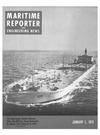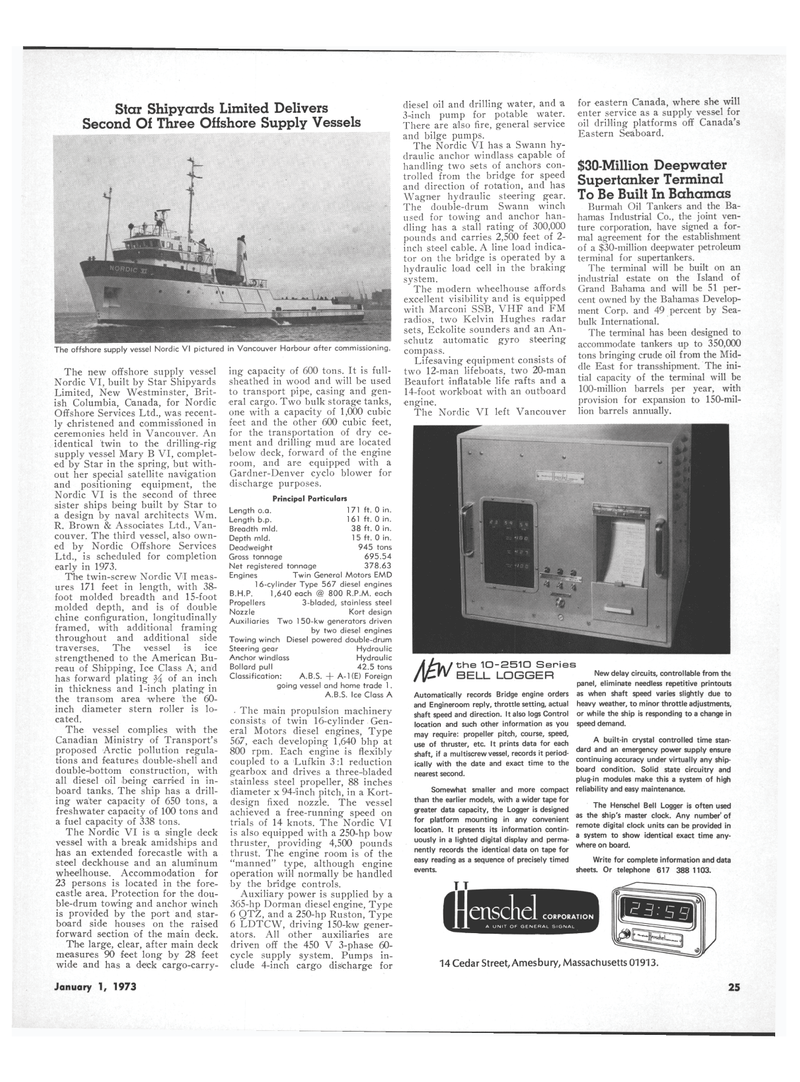
Page 23: of Maritime Reporter Magazine (January 1973)
Read this page in Pdf, Flash or Html5 edition of January 1973 Maritime Reporter Magazine
Star Shipyards Limited Delivers
Second Of Three Offshore Supply Vessels
The offshore supply vessel Nordic VI pictured in Vancouver Harbour after commissioning.
The new offshore supply vessel
Nordic VI, built by Star Shipyards
Limited, New Westminster, Brit- ish Columbia, Canada, for Nordic
Offshore Services Ltd., was recent- ly christened and commissioned in ceremonies held in Vancouver. An identical twin to the drilling-rig supply vessel Mary B VI, complet- ed by Star in the spring, but with- out her special satellite navigation and positioning equipment, the
Nordic VI is the second of three sister ships being built by Star to a design by naval architects Wm.
R. Brown & Associates Ltd., Van- couver. The third vessel, also own- ed by Nordic Offshore Services
Ltd., is scheduled for completion early in 1973.
The twin-screw Nordic VI meas- ures 171 feet in length, with 38- foot molded breadth and 15-foot molded depth, and is of double chine configuration, longitudinally framed, with additional framing throughout and additional side traverses. The vessel is ice strengthened to the American Bu- reau of Shipping, Ice Class A, and has forward plating fy of an inch in thickness and 1-inch plating in the transom area where the 60- inch diameter stern roller is lo- cated.
The vessel complies with the
Canadian Ministry of Transport's proposed Arctic pollution regula- tions and features double-shell and double^bottom construction, with all diesel oil being carried in in- board tanks. The ship has a drill- ing water capacity of 650 tons, a freshwater capacity of 100 tons and a fuel capacity of 338 tons.
The Nordic VI is a single deck vessel with a break amidships and has an extended forecastle with a steel deckhouse and an aluminum wheelhouse. Accommodation for 23 persons is located in the fore- castle area. Protection for the dou- ble-drum towing and anchor winch is provided by the port and star- board side houses on the raised forward section of the main deck.
The large, clear, after main deck measures 90 feet long by 28 feet wide and has a deck cargo-carry- ing capacity of 600 tons. It is full- sheathed in wood and will be used to transport pipe, casing and gen- eral cargo. Two bulk storage tanks, one with a capacity of 1,000 cubic feet and the other 600 cubic feet, for the transportation of dry ce- ment and drilling mud are located below deck, forward of the engine room, and are equipped with a
Gardner-Denver cyclo blower for discharge purposes.
Principal Particulars
Length o.a. 171 ft. 0 in.
Length b.p. 161ft. 0 in.
Breadth mid. 38 ft. 0 in.
Depth mid. 1 5 ft. 0 in.
Deadweight 945 tons
Gross tonnage 695.54
Net registered tonnage 378.63
Engines Twin General Motors EMD 16-cylinder Type 567 diesel engines
B.H.P. 1,640 each @ 800 R.P.M. each
Propellers 3-bladed, stainless steel
Nozzle Kort design
Auxiliaries Two 1 50-kw generators driven by two diesel engines
Towing winch Diesel powered double-drum
Steering gear Hydraulic
Anchor windlass Hydrauli
Bollard pull 42.5 tons
Classification: A.B.S. -f- A-KE) Foreign going vessel and home trade 1.
A.B.S. Ice Class A • The main propulsion machinery consists of twin 16-cylinder Gen- eral Motors diesel engines, Type 567, each developing 1,640 bhp at 800 rpm. Each engine is flexibly coupled to a Lufkin 3 :1 reduction gearbox and drives a three-bladed stainless steel propeller, 88 inches diameter x 94-inch pitch, in a Kort- design fixed nozzle. The vessel achieved a free-running speed on trials of 14 knots. The Nordic VI is also equipped with a 250-hp bow thruster, providing 4,500 pounds thrust. The engine room is of the "manned" type, although engine operation will normally be handled by the bridge controls.
Auxiliary power is supplied by a 365-hp Dorman diesel engine, Type 6 QTZ, and a 250-hp Ruston, Type 6 LDTCW, driving 150-kw gener- ators. All other auxiliaries are driven off the 450 V 3-phase 60- cycle supply system. Pumps in- clude 4-inch cargo disfcharge for diesel oil and drilling water, and a 34nch pump for potable water.
There are also fire, general service and bilge pumps.
The Nordic VI has a Swann hy- draulic anchor windlass capable of handling two sets of anchors con- trolled from the bridge for speed and direction of rotation, and has
Wagner hydraulic steering gear.
The double-drum Swann winch used for towing and anchor han- dling has a stall rating of 300,000 pounds and carries 2,500 feet of 2- inch steel cable. A line load indica- tor on the bridge is operated by a hydraulic load cell in the braking system.
The modern wheelhouse affords excellent visibility and is equipped with Marconi SSB, VHF and FM radios, two Kelvin Hughes radar sets, Eckolite sounders and an An- schutz automatic gyro steering compass.
Lifesaving equipment consists of two 12-man lifeboats, two 20-man
Beaufort inflatable life rafts and a 14-foot work-boat with an outboard engine.
The Nordic VI left Vancouver for eastern Canada, where she will enter service as a supply vessel for oil drilling platforms off Canada's
Eastern Seaboard. $30-Million Deepwater
Supertanker Terminal
To Be Built In Bahamas
Burmah Oil Tankers and the Ba- hamas Industrial Co., the joint ven- ture corporation, have signed a for- mal agreement for the establishment of a $30-million deepwater petroleum terminal for supertankers.
The terminal will be built on an industrial estate on the Island of
Grand Bahama and will be 51 per- cent owned by the Bahamas Develop- ment Corp. and 49 percent by Sea- bulk International.
The terminal has been designed to accommodate tankers up to 350,000 tons bringing crude oil from the Mid- dle East for transshipment. The ini- tial capacity of the terminal will be 100-million barrels per year, with provision for expansion to 150-mil- lion barrels annually. the 10-2510 Series
BELL LOGGER
Automatically records Bridge engine orders and Engineroom reply, throttle setting, actual shaft speed and direction. It also logs Control location and such other information as you may require: propeller pitch, course, speed, use of thruster, etc. It prints data for each shaft, if a multiscrew vessel, records it period- ically with the date and exact time to the nearest second.
Somewhat smaller and more compact than the earlier models, with a wider tape for greater data capacity, the Logger is designed for platform mounting in any convenient location. It presents its information contin- uously in a lighted digital display and perma- nently records the identical data on tape for easy reading as a sequence of precisely timed events.
New delay circuits, controllable from the panel, eliminate needless repetitive printouts as when shaft speed varies slightly due to heavy weather, to minor throttle adjustments, or while the ship is responding to a change in speed demand.
A built-in crystal controlled time stan- dard and an emergency power supply ensure continuing accuracy under virtually any ship- board condition. Solid state circuitry and plug-in modules make this a system of high reliability and easy maintenance.
The Henschel Bell Logger is often used as the ship's master clock. Any number' of remote digital clock units can be provided in a system to show identical exact time any- where on board.
Write for complete information and data sheets. Or telephone 617 388 1103.
V II enscliel
CORPORATION
A UNIT OF GENERAL SIGNAL 14 Cedar Street, Amesbury, Massachusetts 01913.
January 1, 1973 25

 22
22

 24
24
